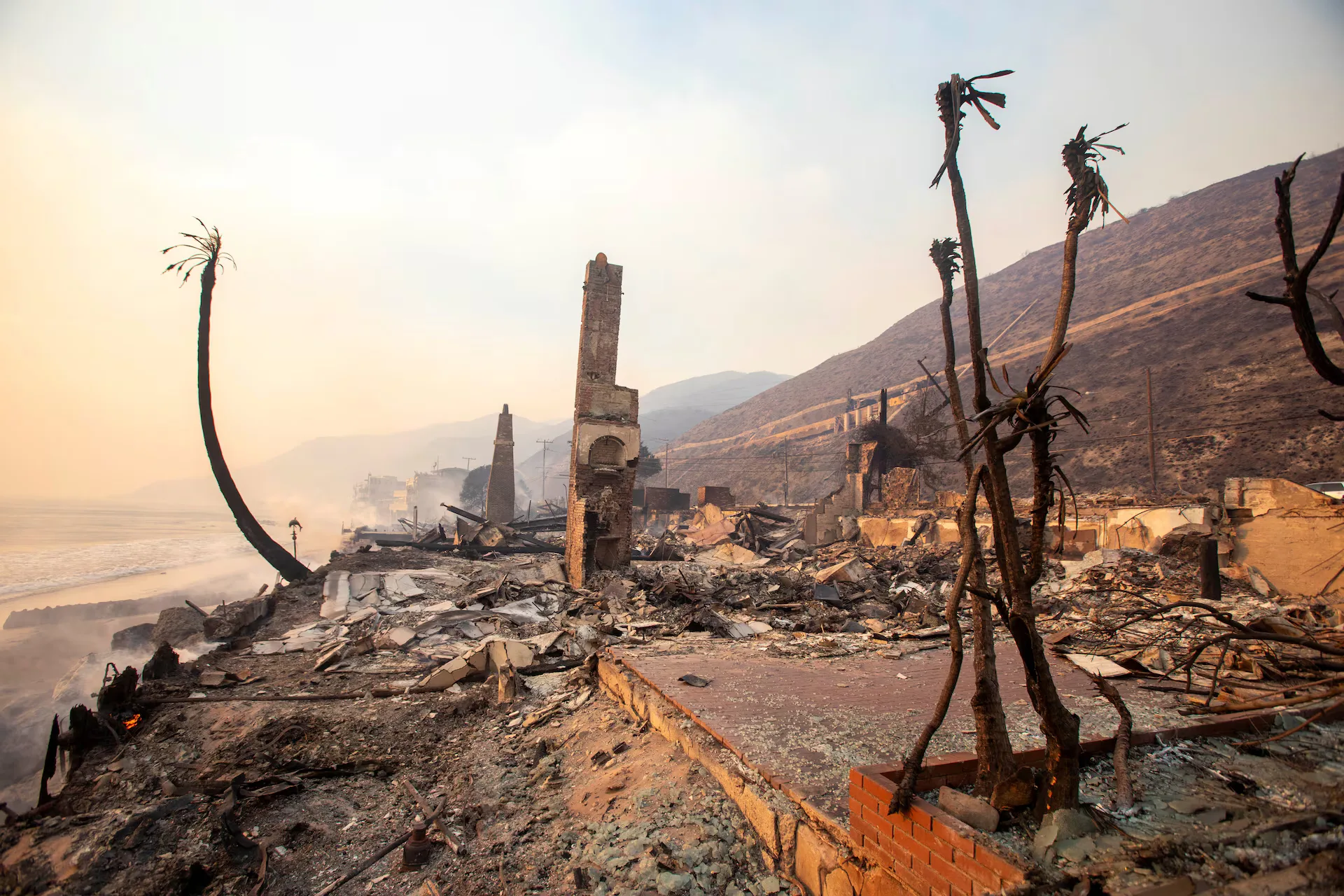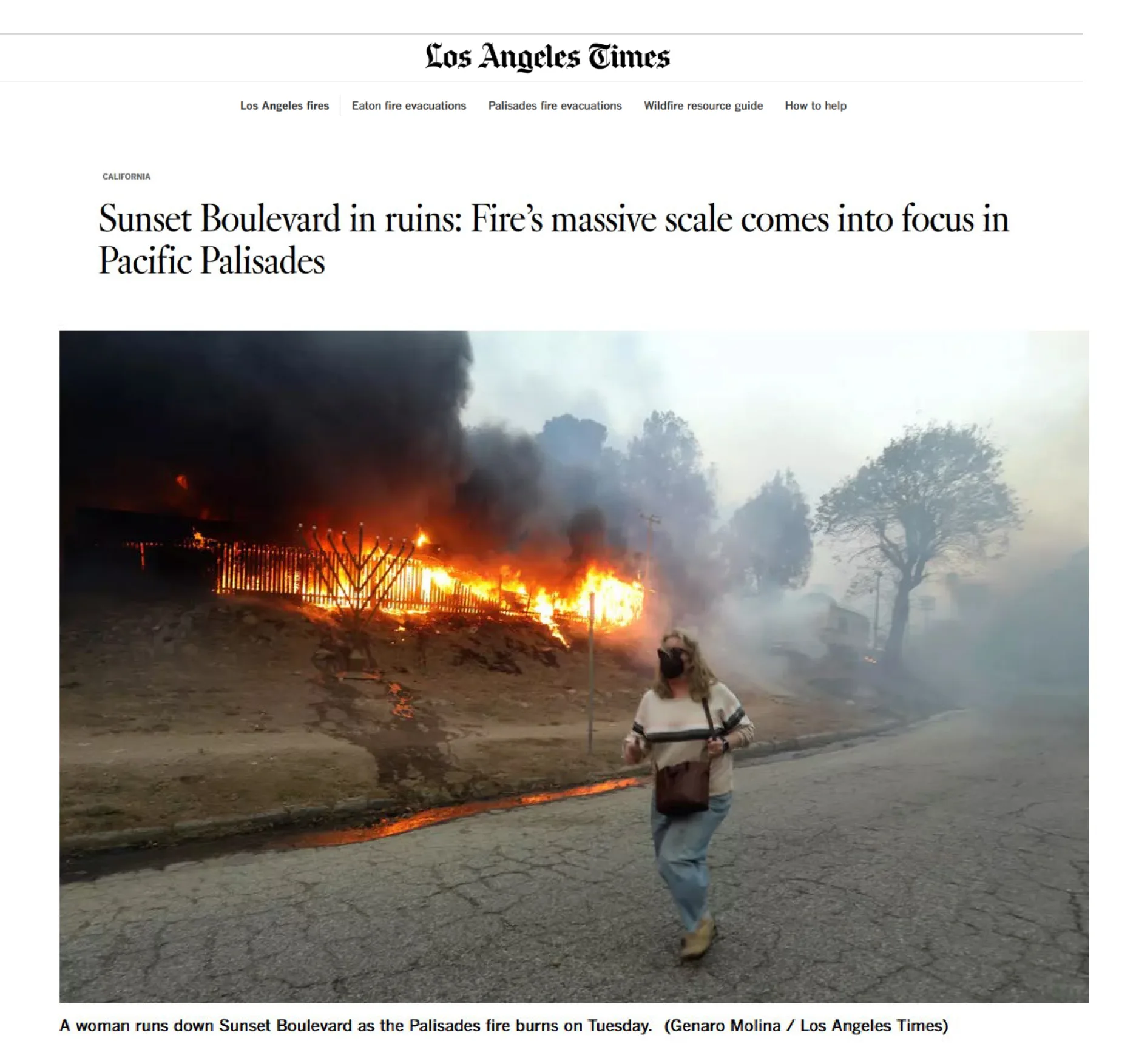
Apocalypse on Sunset Boulevard

(photo credit: LA Times January 8, 2025)
“Sunset Boulevard, twisting boulevardSecretive and rich, a little scarySunset Boulevard, tempting boulevardWaiting there to swallow the unwary”
(Sunset Boulevard by Andrew Lloyd Weber)
“A terrifying experience” is how one Trinity alumna who lives in the Pacific Palisades describes what’s happening with the wildfires that are consuming entire neighborhoods around Los Angeles. The Palisades are in ruins, as is much of Malibu including the once-fabulous homes lining the Pacific Coast Highway along the beach. To the east, the Eaton fire has consumed the neighborhood of Altadena and others. At one point five major fires were raging in the ring of hills around downtown L.A., whipped fast by the relentless Santa Anna winds. More than 150,000 people have evacuated, nearly 10,000 structures including homes destroyed. The photos show a hellscape of unbelievable destruction.
We have many alums who live in the Los Angeles area and I have reached out to them to offer our support in any way possible. A few have replied with gratitude, but no one at this point knows what they are going to need to get through the days ahead. Prayers, of course, and the Trinity sisterhood. We are three thousand miles away but we are all family in the face of such a disaster. And perhaps we have students, staff, faculty and others with family out there — please let me know if you are affected and how Trinity might help.
Over the years I have spent a good deal of time in southern California, first for my work with Georgetown Law Center and later for Trinity. One of the most storied roads in America, I have driven Sunset Boulevard many times, from its origins in downtown Los Angeles to its beautiful end point at the Pacific Ocean. Along the way, the eager tourist could observe a broad swatch of American life and culture from the famous spots in Hollywood to all the shops and cafes and modest homes of the people who work behind the grand scenes of the industries that made L.A. famous to the multi-million-dollar mansions of Brentwood and the Palisades. Sunset Boulevard is a long, winding road carved through the mountainous terrain of the region. Those beautiful mountains, covered with wild brush, contained the seeds of destruction. Now, the humble gas station attendant might be sharing space in the evacuation center with the owners of the fabulous cars that once stopped by for a fill up.

I’ve also driven the Pacific Coast Highway many times, always marveling at what seemed to be the great good fortune of those lucky souls who could afford homes along the beachfront in Malibu, cheek-by-jowl structures all facing the beautiful, expansive, endless Pacific Ocean. So much water! Yet, now beholding the irony of the vast Pacific waters that could not save those homes from fires, all now burnt-out shells. Unimaginable devastation in what was once a “shangri-la” for some.
Writing in the January 10 New York Times, Dr. Peter Kalmus, a climate scientist who left Altadena in 2022 over climate concerns, observes that:
“No place is truly safe anymore. A few months ago, Hurricane Helene pummeled the western part of my new state and the city of Asheville, which many once considered a climate haven. The Pacific Northwest seemed safe until the 2021 heat dome. Hawaii seemed safe until the deadly fires on Maui in 2023.
“For those who have lost everything in climate disasters, the apocalypse has already arrived. And as the planet gets hotter, climate disasters will get more frequent and more intense. The cost of these fires will be immense, and they will affect the insurance industry and the housing market.”
Dr. Kalmus goes on to cite our reliance on fossil fuels and the obtuseness of fossil fuel company executives who have steadfastly refused to cooperate with clean energy initiatives. As I read I could hear the voice of Donald Trump, alas, bragging about how he will “drill, baby, drill”as he derided the “green new scam” in reference to the Green New Deal…. see it here….
Kalmus ended his essay with this warning,
“Nothing will change until our anger gets powerful enough. But once you accept the truth of loss, and the truth of who perpetrated and profited from that loss, the anger comes rushing in, as fierce as the Santa Ana winds.”
Anger was the topic of another essay writer in the New York Times, Patti Davis — daughter of the late President Ronald Reagan — wrote of her memories growing up in the great hills of Los Angeles and her grief over the destruction. She wrote,
“My anger over what we have done to this fragile, exquisite Earth was muffled by grief until the other evening when I was watching a news program that had a panel of commentators. The subject was Los Angeles on fire, and one person mentioned climate change as a cause. Another commentator smirked and said he didn’t believe it was the cause. I felt rage surge up past my grief.”
Davis went on:
“I want us to be angry. Not a destructive anger, a righteous anger. I want us to stand up for an Earth that was created with perfect balance, with beauty and mystery and a divine artistry. An Earth that was put here not for our consumption and our greed but for our nourishment. An Earth that has so much to teach us, and that needs protection, now more than ever. We have thrown an entire planet out of balance, and now we are suffering the consequences — weather patterns so severe we have no idea how to combat them, and the resulting fires, floods, hurricanes, tornadoes, more severe than anything we’ve known before. We can grieve and be righteously angry at the same time.”
Even as people express anger, anguish, fear, despair over the destruction not only of their homes but their entire neighborhoods, ways of life — even as the moment calls for extreme compassion and care for the tens of thousands of displaced persons — even with all of that, some politicians, including the person about to be sworn in as the next president of the United States, could not resist exploiting the horror for their own political purposes. Not satisfied with denying climate change, taunting the governor and blasting the fire department (for what? for not stopping wildfires driven by 100 mph winds?), the once-and-future president and his pals decided to blame — wait for it — DEI! Yes! Diversity, Equity and Inclusion became somehow responsible for the hellacious fires (Diversity brought the matches, Equity poured the gasoline, Inclusion lit them up…. you get the idea)…. Seriously. What triggered them? WOMEN! Yes, women — the Mayor of Los Angeles and the Fire Chief are women. And these women believed in DEI initiatives in their departments. Ergo, says the likes of Elon Musk, DEI (women, really), caused this massive destructive fire.
At some point there are no words left to describe the utterly amoral and despicable political exploitation of this tragedy.
Kalmus and Davis are right to give voice to the anger we all should share at this time, but instead of just railing against the inexplicably depraved political statements, we need to turn our attention to what needs to happen going forward.
How will the thousands of now-homeless people be cared for, not only this week and next week but in the years it will take to recover?
How will the homes be rebuilt? Who will help them negotiate with the not-so-friendly insurance companies? Who will make sure that the state and federal governments live up to promises to assist even as the administrations change.
And what will we do about climate change? The time for denial of the truth is long gone. The wild weather that has afflicted all parts of this country and around the globe is not just a fluke. (Even as the wildfires devastated the Palisades, people were skiing down Peachtree Avenue in Atlanta during a freak snowstorm there.) The planet is growing more and more inhospitable even as some humans redouble their efforts to ignore the signs of our own destruction. We cannot stand silent while the new administration pursues ever more immoral, destructive environmental policies.
Will we have the collective strength to stand up louder, stronger, more confidently for greater environmental protection? Time is growing short. Let’s prove that the answer is YES.